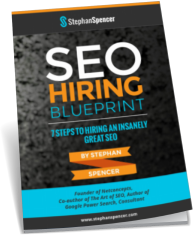This article was originally published on Multi-Channel Merchant.
There’s a time and place for creating a microsite, vs. further building out your main website. If your microsite is likely to gain significantly more traction and interest with the “linkerati” — bloggers journalists, and webmasters who command a lot of PageRank or link authority — by being at arm’s length from your main site, by all means do it.
Consider the hypothetical example of an insurance company launching a blog about staying fit and healthy. If the firm were to incorporate this blog into its own domain name (such as blog.metlife.com or metlife.com/blog), it would be construed as a shill for the company.
But if it were a completely separate site hosted on a unique domain, it would be more trusted by the blogger community. Also bear in mind that bloggers link to other bloggers, not so much to faceless corporate websites and online storefronts.
A microsite may have the added benefit of bypassing some of the legal and PR department hurdles and internal political battles. This could be a key consideration if you’re part of a big monolithic corporation.
But you have to understand that with a microsite, you’re giving up something. Content that is integrated into your main site will get to “ride on the coattails” of the trust, authority, age, history, etc. that your site has established over the years. Whereas a microsite on a brand new domain may wallow in Google’s “sandbox” for a number of months.
One of my favorite microsite success stories is Blendtec’s Willitblend.com. I went into some detail about this company’s YouTube marketing campaign in my June article “Optimizing your videos for YouTube.” But in short, the microsite contains a plethora of entertaining videos showing Blendtec founder Tom Dickson blending all sorts of seemingly non-blendable objects in a Blendtec home blender, including marbles, rake handles, golf clubs and iPads. By offering a one-stop-shop for all the videos on one distinct website, Blendtec provided journalists and bloggers with an ideal location to link to (rather than a series of YouTube URLs).
One key point from the aforementioned article is that links from YouTube to your site don’t pass PageRank. So it’s nowhere near as desirable when folks link to your YouTube videos or YouTube channel as when they link to your microsite.
What’s more, journalists and bloggers would have been less inclined to link to a Blendtec.com URL due to it being too closely associated with a commercial website. So, Blendtec made the right call in splitting out this “Will It Blend” content into a separate microsite.

Make it linkworthy
Highly linkworthy content — such as on WillItBlend.com — is known in the SEO community as “link bait.” Link baiting and microsites go hand-in-hand. If you’re going to build a microsite, it had better be linkworthy.
The fun and mildly insightful “Which Superhero Are You?” personality test wasn’t done simply as a blog post. It was set apart and made special by being hosted on its own microsite: Thesuperheroquiz.com. This helped the quiz (created by two guys — not a major brand) get coverage and links by such PageRank powerhouses as TechCrunch.com.
Further, the site generated a badge for the quiz taker to place on his or her own blog or site to proudly display which superhero he or she is. And of course the badge linked to the company’s microsite, further boosting the site’s link authority.
I described “link baiting” in my March article “How to build links outside the box.” I cited some examples of past successful link bait campaigns, including:
- CounterfeitMini.com
- UpYourBudget.com
- MentosIntern.com
- BackupTrauma.com
- HowManyFiveYearOldsCouldYouTakeInAFight.com
One cardinal SEO sin is retiring a microsite and not 301 redirecting all your hard-earned PageRank to anywhere useful. That’s exactly what happened with the first three aforementioned examples. The fourth only redirected the home page and not any sub-pages, so that also gets a “fail.” The last example is still live — good for them!
In my view, in all cases the content should have stayed up permanently — even after the campaign finished. That’s because high-quality content continues to accumulate links well after the initial promotional blitz. Once you remove that content from the web you kill the opportunity to continue accruing link authority.
Typically, microsites have so few pages that it’s an SEO nightmare. If each page should have a maximum of only three keyword themes, that doesn’t provide for many keyword ranking opportunities. It’s like the antithesis of “long tail SEO.”
A search engine optimal microsite will have at least dozens — hopefully even hundreds — of pages to it.
Setting up your microsite
If you want to launch a microsite, consider buying an aged domain “aftermarket” — hopefully one that has had a site on it for a while. (No, a parking page doesn’t count.) Then change the domain registration information slowly so that the site’s PageRank doesn’t get reset to zero.
Or start the clock running as soon as possible on your new domain by posting at least a few pages to the URL and then getting a few links to it — as far in advance of the official launch as possible.
I’m partial to using WordPress as the content management system for microsites, because of its support for such powerful features as tag clouds, tag pages, RSS feeds, podcasts, pings, comments, trackbacks, etc.
It’s pretty easy to write your own WordPress plugin or widget. Heck, I wrote one, and I’m not a regular programmer. You can pretty easily find a WordPress plugin developer on a website such as elance.com or odesk.com.
If you do go with WordPress, be sure to install my aforementioned plugin, called “SEO Title Tag,” available for free from www.netconcepts.com/seo-title-tag-plugin. It will allow you to craft longer, custom-written title tags that are separate from the “Titles” used in anchor text and H1 tags.


 SIGN UP FOR EXCLUSIVE WEEKLY CONTENT
SIGN UP FOR EXCLUSIVE WEEKLY CONTENT 


Leave a Reply